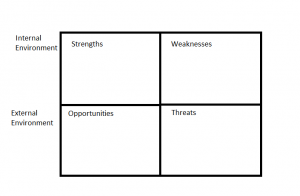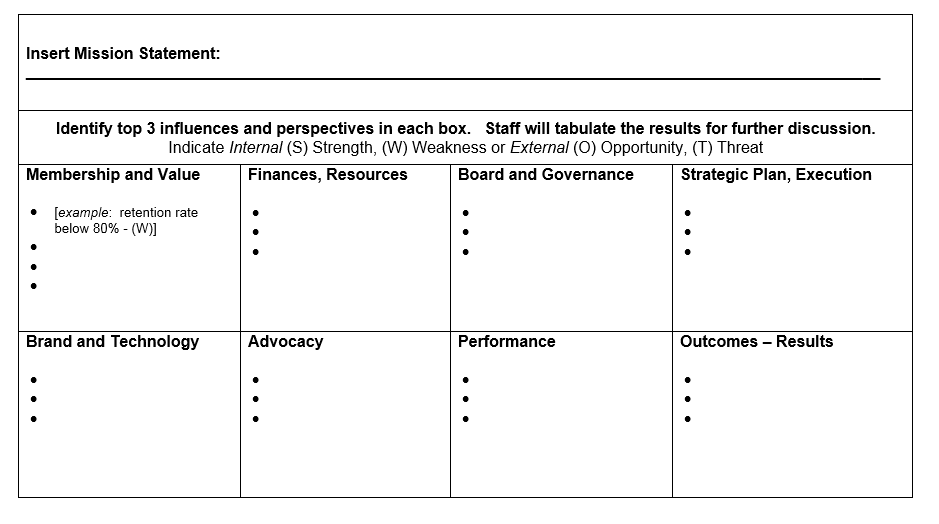“SWOTs suck!” It’s a direct quote by an association executive in a class discussing strategic planning. I may have agreed, probably smiled, but I would not have said it quite like that.
SWOT is a euphemism for a process to analyze the environment affecting an organization. The acronym stands for STRENGTHS, WEAKNESSES, OPPORTUNITIES and THREATS.
It’s purpose is to examine the current situation of an organization by considering internal and external factors. An environmental scan supports better decision making. 
The process explores two realms: internal aspects of the association followed by external factors.
The areas are further broken down into strengths and weaknesses (internal) and opportunities and threats (external).
Strategic Planning
Conducting a SWOT is associated with strategic planning. The exercise might be posed as, “Let’s begin by identifying the strengths, weaknesses, opportunities and threats for the organization.”
The discussion encourages directors to share perspectives. Most are eager to see their input added to the flipchart or SWOT quadrant.
Some problems exist with the process. After reading hundreds of SWOT reports it is disconcerting that you cannot distinguish the difference between an agricultural group and medical association. Both board might offer the generalities, “We have a great staff,” and “Government regulation is a threat.”
During the process it could be that “group think” takes over — directors affirming ideas of their board colleagues. Most of the input is subjective without referencing performance metrics.
Another problem is the level of discussions. The planning process should encourage innovative and visionary thinking. But SWOT discussions dip into the weeds with questions and opinions. It is an hour that might distract from strategic thinking.
Organic SWOT
If the right people are at the planning table the environmental scan will happen naturally, without allocating time to throw ideas on the board.
The book Good to Great suggests successful companies have the right people on the bus – in the right seats. The same holds true of the strategic planning process.
The right people will be persons on the board who are visionaries. They should be able to speak for the community, members and stakeholders because they do their own continuous environmental scan.
The number of people at the meeting should allow for meaningful conversations. Too few lacks diversity of input and representation. Too many and people struggle to be heard.
The more people at the meeting, the longer the day in a process that requires intense concentration.
SWOT Adaptations
An environmental scan has value in various forms. Rather than conducting it annually or only at the retreat, consider these approaches.
- Encourage directors to scan the environment continuously, with regular report to the board. Allocate time at meetings for visionary discussions, i.e. 2020 to 2025.
- Take advantage of a prior SWOT report. Rather than starting from scratch, pull the last SWOT to discuss what has changed.
- Subscribe to publications; assign board members to monitor certain organizations, stakeholders and trends so when the planning begins it flows organically without forcing a SWOT where the results look just like the association next door. At the Illinois Park and Recreation Association, Debbie Trueblood, MSW, IOM, CAE, explains, “We do an environmental scan twice a year, doing a deep dive on a specific issue.”
- Invite respected visionaries to address the planning group before the meeting begins. For example, invite representatives of government, publishing, futurist, economist, etc. to address the board for 20 minutes each. After their presentations and board questions they can be excused.
- Do the scan in advance of strategic planning. Provide a framework so board members can add their own perspectives. The staff will tabulate and summarize for discussion at the next meeting.
- Redesign the criteria to build upon the SWOT model. Rather than the breakdown of internal and external that results in general statements, “great staff,” “more members,” align discussions with the association’s key criteria.

An environmental scan is part of good governance and operations. Adapt the SWOT process to have greater value for the association.
# # #
Note: Bob Harris, CAE, provided free tips and templates at www.nonprofitcenter.com
Leave a Reply